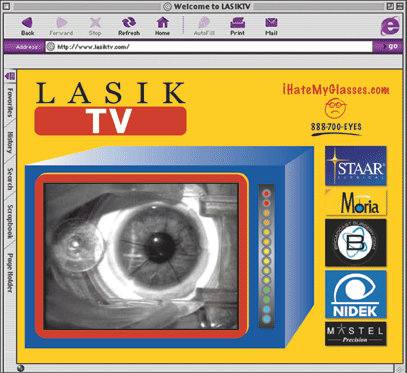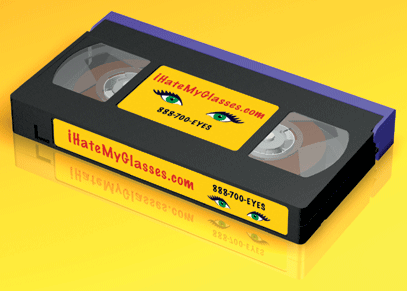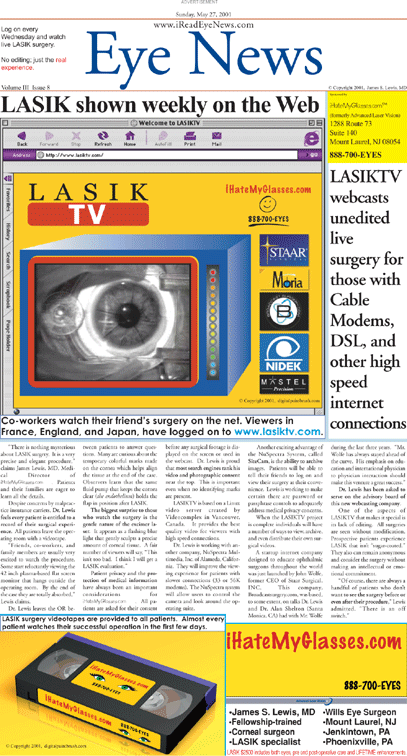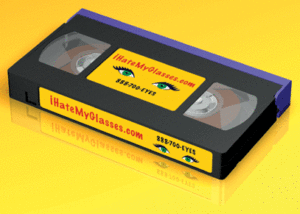Philadelphia / Bucks County LASIK Surgeon – Dr. James S. Lewis
Eye News Volume III Issue 8

LASIK shown live every Wednesday on the Web

Co-workers watch their friend’s surgery on the net. Viewers in France, England, and Japan, have logged on to www.lasiktv.com.
LASIKTV webcasts unedited surgery live for those with Cable Modems, DSL, and other high speed internet connections
“There is nothing mysterious about LASIK surgery. It is a very precise and elegant procedure,” claims James Lewis, MD, Medical Director of iHateMyGlasses.com. Patients and their families are eager to learn all the details.
Despite concerns by malpractice insurance carriers, Dr. Lewis feels every patient is entitled to a record of their surgical experience. All patients leave the operating room with a videotape.
“Friends, co-workers, and family members are usually very excited to watch the procedure. Some start reluctantly viewing the 42 inch plasma-based flat screen monitor that hangs outside the operating room. By the end of the case they are totally absorbed,” Lewis claims.
Dr. Lewis leaves the OR between patients to answer questions. Many are curious about the temporary colorful marks made on the cornea which helps align the tissue at the end of the case. Observers learn that the same fluid pump that keeps the cornea clear (the endothelium) holds the flap in position after LASIK.
The biggest surprise to those who watch the surgery is the gentle nature of the excimer laser. It appears as a flashing blue light that gently sculpts a precise amount of corneal tissue. A fair number of viewers will say, “This isn’t too bad. I think I will get a LASIK evaluation.”
Patient privacy and the protection of medical information have always been an important considerations for iHateMyGlasses.com. All patients are asked for their consent before any surgical footage is displayed on the screen or used in the webcast. Dr. Lewis is proud that most search engines rank his video and photographic consent near the top. This is important even when no identifying marks are present.
LASIKTV is based on a Linux video server created by Videocomplex in Vancouver, Canada. It provides the best quality video for viewers with high speed connections.
Dr. Lewis is working with another company, NuSpectra Multimedia, Inc. of Alameda, California. They will improve the viewing experience for patients with slower connections (33 or 56K modems). The NuSpectra system will allow users to control the camera and look around the operating suite.
Another exciting advantage of the NuSpectra System, called SiteCam, is the ability to archive images. Patients will be able to tell their friends to log on and view their surgery at their convenience. Lewis is working to make certain there are password or passphrase controls to adequately address medical privacy concerns.
When the LASIKTV project is complete individuals will have a number of ways to view, archive, and even distribute their own surgical videos.
A startup internet company designed to educate ophthalmic surgeons throughout the world was just launched by John Wolfe, former CEO of Staar Surgical, INC. This company, Broadcastsurgery.com, was based, to some extent, on talks Dr. Lewis and Dr. Alan Shelton (Santa Monica, CA) had with Mr. Wolfe during the last three years. “Mr. Wolfe has always stayed ahead of the curve. His emphasis on education and international physician to physician interaction should make this venture a great success.”
Dr. Lewis has been asked to serve on the advisory board of this new webcasting company.
One of the aspects of LASIKTV that makes it special is its lack of editing. All surgeries are seen without modification. Prospective patients experience LASIK that isn’t “sugar-coated.” They also can remain anonymous and consider the surgery without making an intellectual or emotional commitment.
“Of course, there are always a handful of patients who don’t want to see the surgery before or even after their procedure,” Lewis admitted. “There is an off switch.”
Despite concerns by malpractice insurance carriers, Dr. Lewis feels every patient is entitled to a record of their surgical experience. All patients leave the operating room with a videotape.
“Friends, co-workers, and family members are usually very excited to watch the procedure. Some start reluctantly viewing the 42 inch plasma-based flat screen monitor that hangs outside the operating room. By the end of the case they are totally absorbed,” Lewis claims.
Dr. Lewis leaves the OR between patients to answer questions. Many are curious about the temporary colorful marks made on the cornea which helps align the tissue at the end of the case. Observers learn that the same fluid pump that keeps the cornea clear (the endothelium) holds the flap in position after LASIK.
The biggest surprise to those who watch the surgery is the gentle nature of the excimer laser. It appears as a flashing blue light that gently sculpts a precise amount of corneal tissue. A fair number of viewers will say, “This isn’t too bad. I think I will get a LASIK evaluation.”
Patient privacy and the protection of medical information have always been an important considerations for iHateMyGlasses.com. All patients are asked for their consent before any surgical footage is displayed on the screen or used in the webcast. Dr. Lewis is proud that most search engines rank his video and photographic consent near the top. This is important even when no identifying marks are present.
LASIKTV is based on a Linux video server created by Videocomplex in Vancouver, Canada. It provides the best quality video for viewers with high speed connections.
Dr. Lewis is working with another company, NuSpectra Multimedia, Inc. of Alameda, California. They will improve the viewing experience for patients with slower connections (33 or 56K modems). The NuSpectra system will allow users to control the camera and look around the operating suite.
Another exciting advantage of the NuSpectra System, called SiteCam, is the ability to archive images. Patients will be able to tell their friends to log on and view their surgery at their convenience. Lewis is working to make certain there are password or passphrase controls to adequately address medical privacy concerns.
When the LASIKTV project is complete individuals will have a number of ways to view, archive, and even distribute their own surgical videos.
A startup internet company designed to educate ophthalmic surgeons throughout the world was just launched by John Wolfe, former CEO of Staar Surgical, INC. This company, Broadcastsurgery.com, was based, to some extent, on talks Dr. Lewis and Dr. Alan Shelton (Santa Monica, CA) had with Mr. Wolfe during the last three years. “Mr. Wolfe has always stayed ahead of the curve. His emphasis on education and international physician to physician interaction should make this venture a great success.”
Dr. Lewis has been asked to serve on the advisory board of this new webcasting company.
One of the aspects of LASIKTV that makes it special is its lack of editing. All surgeries are seen without modification. Prospective patients experience LASIK that isn’t “sugar-coated.” They also can remain anonymous and consider the surgery without making an intellectual or emotional commitment.
“Of course, there are always a handful of patients who don’t want to see the surgery before or even after their procedure,” Lewis admitted. “There is an off switch.”

LASIK surgery videotapes are provided to all patients. Almost every patients watches their successful operation in the first few days.

Dr. James Lewis has many years’ experienced performing LASIK an Epi-LASIK in Philly. His record of outstanding surgical outcomes and impeccable patient care has helped him earn a reputation as a leading Philadelphia LASIK specialist. In addition to laser eye surgery, Dr. Lewis specializes in glaucoma therapy and implantation of Visian ICLs.

